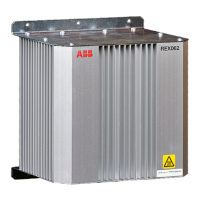margin. Fully asymmetrical fault current will be achieved when the fault occurs at
approximately zero voltage (0°). Investigations have shown that 95% of the faults in
the network will occur when the voltage is between 40° and 90°. In addition fully
asymmetrical fault current will not exist in all phases at the same time.
24.1.3 Fault current
The current transformer requirements are based on the maximum fault current for
faults in different positions. Maximum fault current will occur for three-phase faults
or single phase-to-earth faults. The current for a single phase-to-earth fault will exceed
the current for a three-phase fault when the zero sequence impedance in the total fault
loop is less than the positive sequence impedance.
When calculating the current transformer requirements, maximum fault current for
the relevant fault position should be used and therefore both fault types have to be
considered.
24.1.4 Secondary wire resistance and additional load
The voltage at the current transformer secondary terminals directly affects the current
transformer saturation. This voltage is developed in a loop containing the secondary
wires and the burden of all relays in the circuit. For earth faults the loop includes the
phase and neutral wire, normally twice the resistance of the single secondary wire. For
three-phase faults the neutral current is zero and it is just necessary to consider the
resistance up to the point where the phase wires are connected to the common neutral
wire. The most common practice is to use four wires secondary cables so it normally
is sufficient to consider just a single secondary wire for the three-phase case.
The conclusion is that the loop resistance, twice the resistance of the single secondary
wire, must be used in the calculation for phase-to-earth faults and the phase resistance,
the resistance of a single secondary wire, may normally be used in the calculation for
three-phase faults.
As the burden can be considerable different for three-phase faults and phase-to-earth
faults it is important to consider both cases. Even in a case where the phase-to-earth
fault current is smaller than the three-phase fault current the phase-to-earth fault can
be dimensioning for the CT depending on the higher burden.
In isolated or high impedance earthed systems the phase-to-earth fault is not the
dimensioning case. Therefore, the resistance of the single secondary wire can always
be used in the calculation for this kind of power systems.
24.1.5 General current transformer requirements
The current transformer ratio is mainly selected based on power system data for
example, maximum load and/or maximum fault current. It should be verified that the
current to the protection is higher than the minimum operating value for all faults that
Section 24 1MRK 502 071-UEN -
Requirements
746 Generator protection REG670 2.2 IEC and Injection equipment REX060, REX061, REX062
Application manual

